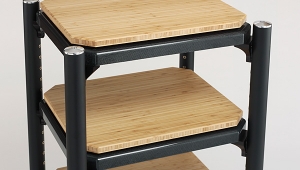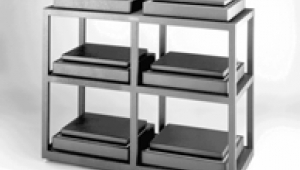| Columns Retired Columns & Blogs |
Bright Star Audio Rack of Gibraltar 2 equipment rack Page 2
Rapping the rack directly did cause a slight ripple on the water's surface, but this is where the rest of the Bright Star isolation system comes in. When I set the water glass on an Air Mass/Big Rock combo, and the whole stack on the RoG, no amount of rapping, tapping, or even thumping was translated to the water's surface. In contrast, setting the glass of water and Air Mass/Big Rock setup on a light, rigid end-table provided nowhere near as much isolation; nearby footfalls clearly perturbed the water.
What does this all mean for your system? First of all, its exceptional stability and isolation make the Rack of Gibraltar, with an Air Mass/Big Rock combo, one of the few general-purpose racks that I would recommend using with a turntable. In fact, I've used RoGs in turntable comparisons in the past, to ensure that I was hearing each 'table under identical—and optimal—conditions. I've used the setup with four different turntables over the past five years: with a SOTA Cosmos, a Well Tempered Reference, a VPI TNT IV, and an Immedia RPM-2. Although each had a very different suspension system, all worked beautifully with the Bright Star system.
In one comparison, I moved my Immedia RPM-2 between an RoG and a decent but less-stout rack I have, and with each setup listened to the Heifetz/Primrose/Piatigorsky recording of Beethoven's Serenade in D, Op.9 No.2 (RCA LSC-2550). Switching to the Bright Star rack actually seemed to add a third dimension to both the images and the soundstage. Subtleties—small fingering details, the textures of the bows against the strings, the resonances of the instruments' bodies—were simultaneously more apparent and more interwoven into the fabric of the music. The instruments sounded more vivid, alive, and tangible.
The Rack of Gibraltar worked well, too, with preamplifiers and digital sources; with these, using the Bright Star system resulted in noticeable improvements in detail resolution and focus. My VAC CPA1 Mk.III preamp sounded clearer and sharper on the RoG/Air Mass/Big Rock combination, and its noise floor was unquestionably lowered, making images more dimensional and allowing me to hear deeper into the soundstage.
Two CD players in particular—the Ultech UCD-100 and Parasound CD/P1000—seemed to benefit significantly from the Bright Star treatment, sounding a bit lifeless and two-dimensional with my other equipment rack. Dynamic transients seemed cleaner with the Bright Start setup as well, and actually sounded larger. At the same volume setting, the entire system seemed to be playing louder, with more snap and life.
What would I change?
Air-suspension racks are all the rage, it seems; with their Air Mass bases, Bright Star was an early adopter of the technology. So why not a rack with integral pneumatic suspension? Because, according to Bright Star's Barry Kohan, components need to be individually suspended and isolated to prevent vibrations generated by one from bleeding into another. The only way to cover all the bases, according to Kohan, is to start with a massive, inert base, and then cocoon each component from there.
Makes sense, and the setup is effective and versatile...and I hate to be a whiner, but it is cumbersome to stack up an Air Mass, Big Rock, and CD player, then top it all with a Little Rock. You end up with a sort of "leaning tower of Bright Star"—disconnecting a typical heavy audiophile cable sets it all to swaying horrifyingly to and fro. I can't help but wonder if it might work as well to integrate one of Bright Star's Gemini platforms (which combine an Air Mass and Big Rock into a single, low-profile unit) directly into the rack, as its shelves. But most users don't constantly switch gear in and out, so it's probably not an issue.
Summing Up
Bright Star Audio's Rack of Gibraltar is a well-designed, superbly built audio rack. At $1995, it's expensive, but it's also the best I've ever used. Combined with the other components of Bright Star's Ultimate Isolation System, it provides excellent isolation and damping for audio components, and its size and stability afford the opportunity to effectively house an entire system—including an analog front-end—in a single rack.
It isn't gorgeous, stunning, or flashy. It doesn't look like something from the bridge of the Starship Enterprise, and it doesn't look like a sumptuous yew-wood armoire custom-matched to your den—because it's neither. It looks like what it is, and exactly as it must to most effectively do what it was designed to do. In the case of the Rack of Gibraltar 2, form truly does follow function.
- Log in or register to post comments
























